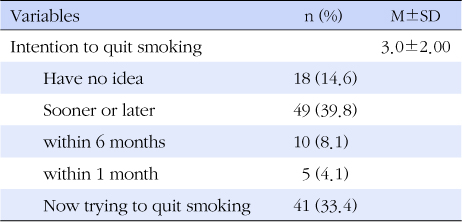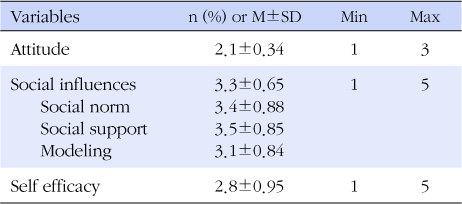References
1. Armstrong BK, White E, Saracci R. Principles of exposure measurement in epidemiology Oxford: Oxford University Press; 1992.
2. Choi EY, Jeong SH. The effect of self-efficacy promotion smoking cessation program on the amount of smoking, CO, urine cotinine level and self-efficacy for adolescent smokers. J Korean Biol Nurs Sci 2012;14(2):103–111.
3. Choo J, Kim EK. Application of the ASE Model to the assertive behavior of non-smoking college students under secondhand smoke exposure. J Korean Acad Community Health Nurs 2011;22(1):1–10.
4. Chung YS, So H. Knowledge, attitude and experience on smoking among primary school students. J Korean Soc Health Educ Prom 2003;20(3):189–205.
5. Coleman P. Overview of substance abuse. Prim Care 1993;20(1):1–18.
6. DiClemente CC, Prochaska JO, Gibertini M. Self-efficacy and staged of self-change of smoking. Cognitive Ther Res 1985;9(2):181–200.
7. Graduate School of Public Health, Yonsei University. Graduate School of Public Health, Yonsei University. Global Youth Tobacco Survey (GYTS) Korean Version Seoul: Yonsei University Press; 2002.
8. Holm K, Kremers SP, de Vries H. Why do Danish adolescents take up smoking. Eur J Public Health 2003;13(1):67–74.
9. Hwang BD. Knowledge, attitude and factors for smoking behavior in high school students. J Korean Soc Health Educ Prom 2007;24(2):45–61.
10. Hyeon JH. Adolescents' smoking cessation intention & the factors affecting smoking cessation intention Seoul: Seoul National University; 2009. Unpublished master's thesis.
11. Jang JY. Analysis of related factors on middle school student smoking in Korea Seoul: Yonsei University; 2005. Unpublished master's thesis.
12. Kim HO. A study on the smoking related social influence, refusal skill and nonsmoking related self-efficacy among adolescents. J Korean Acad Child Health Nurs 2003;9(3):237–249.
14. Korean Association of Smoking and Health. A study on survey of smoking the first half year 2011 (Prss release of Ministry for Health, Welfare and Family Affairs) 2011. 12. 12. Retrieved Feburary 11, 2013. from
http://www.kash.or.kr/user_new/pds_view.asp.
15. Kowalski SD. Self-esteem and self-efficacy as predictors of success in smoking cessation. J Holist Nurs 1997;15(2):128–142.
16. Kwak YH. The study of factors of parents and peers influencing on the adolescent smoking Busan: Silla University; 2011. Unpublished master's thesis.
17. Lee HI. Relationship between the smoking behavior and risk-taking tendency and peer pressure in adolescents Seoul: Seoul National University; Unpublished master's thesis.
18. López ML, Herrero P, Comas A, Leijs I, Cueto A, Charlton A, et al. Impact of cigarette advertising on smoking behaviour in Spanish adolescents as measured using recognition of billboard advertising. Eur J Public Health 2004;14(4):428–432.
19. Maassen IT, Kremers SP, Mudde AN, Joof BM. Smoking initiation among Gambian adolescents: Social cognitive influences and the effect of cigarette sampling. Health Educ Res 2004;19(5):551–560.
20. Moon IO, Park KO. Youth's smoking status in Seoul in the international perspective: Overall comparisons with the results of the Global Youth Tobacco Survey (GYTS). J Korean Soc Sch Health Educ 2005;6:1–16.
21. Oh VC. Related factors with the stage of change of smoking cessation in adolescent: Based on the trnastheoretical model Seoul: Seoul National University; 2002. Unpublished master's thesis.
22. Paek KS, Choi YH. High school students' knowledge and attitude about smoking according to their smoking status. J Korean Acad Community Health Nurs 2004;15(2):277–288.
23. Park J, Min S, Jang JY. A study on the influence of smoking expectancy-value and normative beliefs on nonsmoking behavioral intention. J Public Relat Res 2010;14(3):234–260.
24. Park YG, Kang YJ. Behavior, Knowledge and Attitude on smoking of primary school children. J Korean Acad Fam Med 1996;17(9):798–809.
25. Park YI. A study on the factors affecting smoking cessation behavior of university student smokers. J Korean Acad Soc Nurs Educ 2004;10(2):229–238.
26. Pavanello S, Clonfero E. Biomakers of genotoxic risk and metabolic polymorphisms. Med Lav 2000;91(5):431–469.
27. Ryu SY, Shin JH, Kang MG, Park J. Factors associated with intention to quit smoking among male smokers in 13 communities in honam region of Korea: 2010 community health survey. J Korean Soc Health Educ Prom 2011;28(2):5–85.
28. Whang HS. Predictive factors for intention of smoking cessation among youth smokers Busan: Kosin University; 2000. Unpublished master's thesis.




